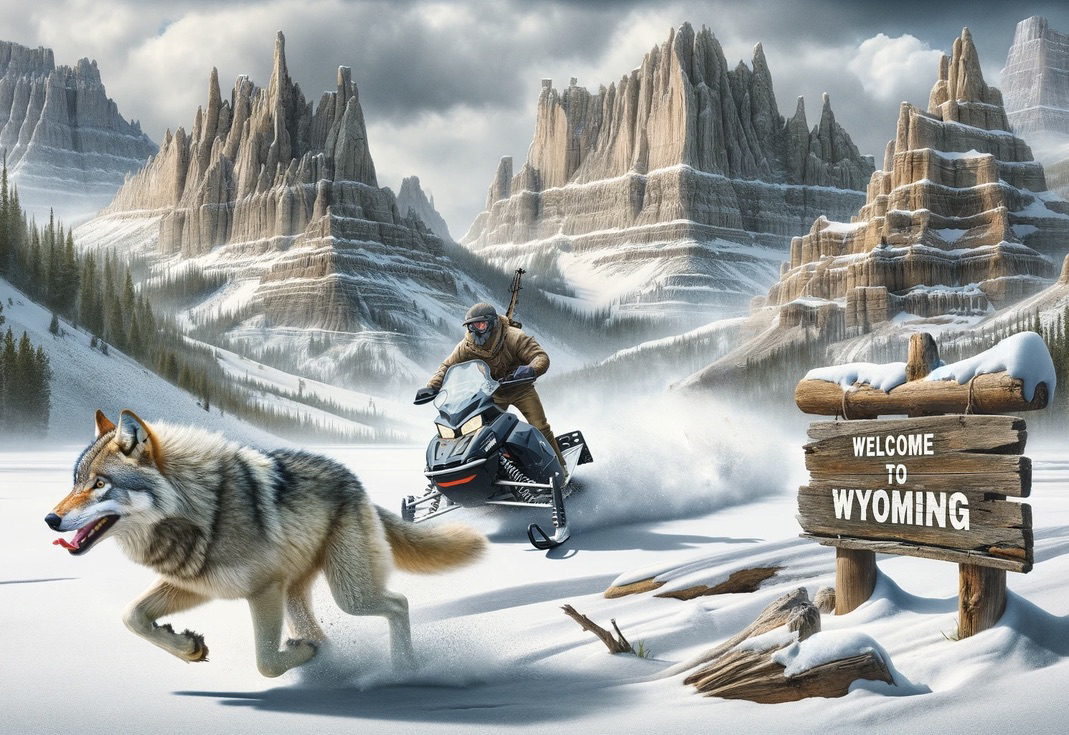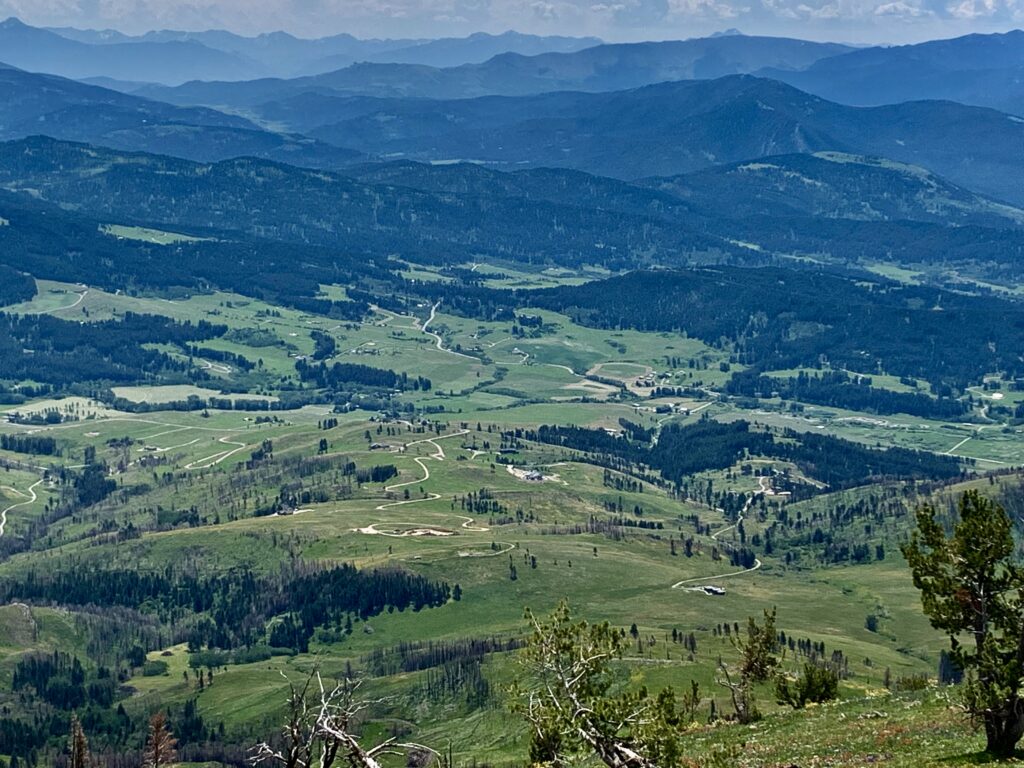by Todd Wilkinson
Right now Wyoming finds itself on trial in the court of international public opinion. If the chatter circulating prolifically on social media is any indication, the state is losing an argument it is trying to make, which is that it hovers as a beacon of modern wildlife management.
Indeed a bright beam of scrutiny has befallen it, in light of a recent incident involving a Wyoming man who allegedly ran over a young wild wolf with his snowmobile and then brought the injured animal to a bar before killing it.
The last time public furor of this magnitude has been directed toward the state was in 1998 when Matthew Shepard, a gay student at the University of Wyoming was beaten, tortured and left to die outside the college town of Laramie. His murder shocked the country and it set off a debate about whether it was really the result of a hate crime or a robbery unrelated to Shepard’s gender affiliation—and whether Wyoming laws were sufficient to punish those may who committed the former.
Inarguable is Wyoming’s collective identity as a state that proudly counts itself among the most conservative in the country. Manifestations of that include denial of climate change and its connection to fossil fuels, efforts to have books banned in public schools, and hostility continuously vented toward the federal government and environmentalists. Another example of just how far to the right the culture continues to veer is the 2022 primary defeat of incumbent Congresswoman Liz Cheney, daughter of former Vice President Dick Cheney who was once widely popular, by insurgent candidate Harriet Hageman.
Wyoming has, for many years, deflected criticism brought by wildlife advocates who say the state fosters a culture of overt hatred toward wolves, coyotes and other native species dating back to before its founding in 1890.
Villainized as adversaries to ranchers and treated as unwanted competitors to big game hunters, wolves are also portrayed in some corners of the Equality State as being imminent threats to people. Today, it’s allowable to kill wolves and coyotes in more than four fifths of Wyoming using almost any means. It’s literally open season, 24 hours a day, 365 days a year, no questions asked and apparently no explanation expected.
Nowhere else in modern American wildlife management has a native wildlife species, brought back from the brink and commanding strong favorable impressions with the public been treated with such open disdain that also, its critics say, is reflected in public policy.
So that readers understand in blunt terms what the above means, wolves and coyotes can be killed in most of the state in unlimited number without their pursuers even having to secure a hunting license. They can be trapped, shot, snared, baited into gunning range, poisoned, chased with hounds and motorized vehicles, and shot from airplanes enlisted by authorized government personnel.
It’s legal, too, thanks to their special almost-anything-goes “predator” classification invented by the legislature, to pour gasoline into a wolf or coyote den, with pups inside, and then light them afire. To protect individuals who kill wolves, legislators passed a code that keeps their identities secret in order to shield them from receiving any potential harassment.
Seldom, until recently, have state leaders had to answer for Wyoming’s controversial anti-predator policies, laws and attitudes. They exist not only as tools of eradication but as an expression, observers say, declaring that Wyoming still resents federally-induced wolf and grizzly recovery that politicians have said was done against the will of the state.
Wolf conservationists, meanwhile, point to the irony of that mindset and note that nearly all of the negative contentions—that wolves, in particular, cause huge economic losses to ranchers, that they decimate big game herds, that they represent a menace to human safety and are the spawn of the devil—are refuted by confirmable facts.
Wildlife tourism in the northwest corner of Wyoming, which encompasses Yellowstone and Grand Teton national parks, ranks among the state’s most reliable economic engines. It annually nets billions of dollars in spending from nature-loving visitors who excitedly flock to the state from across the globe. According to ongoing analyses from the National Park Service, those two crown jewel national parks alone are magnets that generate upwards of $1.5 billion annually in economic activity and along with it, create 15,000 jobs.
Notably, two of the top three attractions to Yellowstone, one park visitor survey found, are wolf and grizzly bear watching. In Jackson Hole, the fascination with Grizzly 399 and successions of her cubs over the last two decades has been a catalyst for generating more nature-tourism dollars in a single year than Wyoming has spent on grizzly recovery, in toto, (around $60 million) since the Greater Yellowstone population of grizzlies was given federal protection in 1975. This demonstrates how live grizzlies are a bullish asset that, like protected public lands, only accrue more value over time.
But for the presence of Yellowstone and Grand Teton national parks, and their existing as wildlife preserves and hooks for conservation, it’s possible that grizzlies would have disappeared from Wyoming during the 20th century as they did in Colorado. Many believe it’s doubtful wolves would exist.
All of this provides essential backdrop/context for pondering what has become one of the most notorious wolf-killing incidents in modern times.
° ° ° °
On February 29, 2024, 42-year-old Sublette County, Wyoming resident Cody Roberts reportedly engaged in the following behavior. The details of what he allegedly did are based on reporting by Wyofile journalist Mike Koshmrl and Cowboy State Daily journalists Mark Heinz, Jimmy Orr and Greg Johnson. Some of the facts have not been independently verified by Yellowstonian.
According to Koshmrl’s story, based on an anonymous source, Roberts, driving a snowmobile, allegedly ran down a wild wolf to the point of exhaustion, captured the traumatized injured juvenile animal, wrapped its muzzle with duct tape, brought it to his home, then transported it to the Green River Bar in Daniel to show off the wounded animal to tavern patrons. After that, he killed it. According to Koshmyrl’s reporting, based on an eyewitness in the bar, Roberts may also have placed a shock collar around the wolf’s neck.
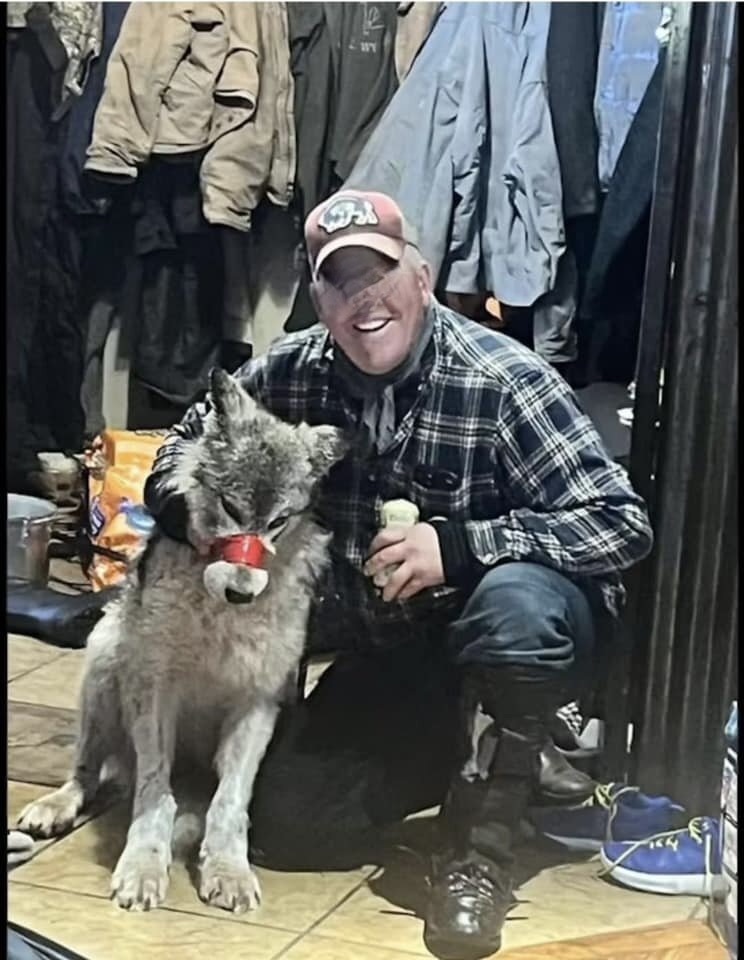
So much for the frightening fairy tale depictions of a big bad wolf that must be subdued. In a video obtained by Cowboy State Daily, Roberts is seen offering the wolf a mock display of affection not long, apparently, before he killed it. “The shocking video appears to show Roberts holding the injured wolf and then bringing its head up to his lips and then kissing it,” reporters Jimmy Orr and Greg Johnson of Cowboy State Daily write. “The wolf bears its teeth some, but appears too weak to react. A woman in the background is heard laughing during the entirety of the clip. The source who supplied the video to Cowboy State Daily, who prefers to remain anonymous, said the video was shot in the Green River Bar.”
A short report, based on an interview carried out with Roberts by two Wyoming Game and Fish wardens, states that Roberts admitted capturing the wolf, bringing it to the bar and killing it, but the partially redacted document, which the state only released after coming under public pressure, does not mention Roberts running the animal down with a snowmobile.
Cat Urbigkit, a writer, book author, and correspondent for the Wyoming Livestock Roundup, penned a piece asserting that facts of the case depart from what has been alleged. She claimed reports that Roberts drove over the wolf with his snowmobile are, so far, unsubstantiated.
In particular Urbigkit took aim at animal rights activists. She suggests that rhetoric circulated by some of them on social media inflamed the public and brought an onslaught of death threats directed at Roberts, his family, employees of Wyoming Game and Fish and owners of the bar. She writes: “Much of the rhetoric against Roberts resembles what researchers call dehumanization, in which people are singled out and treated as less than human and outside the scope of human morality and justice, so any harm which befalls them is therefore morally justified.”
It should be noted that Urbigkit, who owns a sheep ranch in western Wyoming near Pinedale, had been a vocal opponent of Yellowstone wolf reintroduction to begin with, and she and her husband, Jim, joined in a lawsuit to halt reintroduction from happening. Had they prevailed, wolf recovery might never have occurred. Many of Urbigkit’s depictions of wolves have been debunked by facts. In response to her missive in the Roundup, one wildlife advocate pointed to the irony of Urbigkit’s op-ed insinuating Roberts is some kind of victim, being de-humanized as he stands accused of engaging in inhumane undignified behavior that otherwise would be deemed criminal if a person had done the same thing to a sheep in her flock.They say rural Wyomingites over the years have been guilty of singling out wolves and treating them as less than human outside the scope of human mortality and justice.
Many conservationists have characterized the Roberts incident as a case of barbaric depravity. Mr. Roberts, to date, has not been charged with any crime involving animal cruelty because of loopholes that Wyoming officials have invoked pertaining to wolves. He did, however, pay a fine of $250, not for killing the wolf but for illegally possessing a warm-blooded animal. Petitions floating around on the internet have collected tens of thousands of digital signees demanding that tougher charges be brought against Roberts, but what would those be?
Emily Cohen, executive director of public radio station KHOL in Jackson Hole, deserves praise. She first reported on the story and, if she hadn’t, it might never have come to light. Only after news of the event surfaced weeks after the fact and then spread like wildfire via social media internationally did public officials in Wyoming respond with what some describe as confusing statements of condemnation. The first came from a spokesperson with the Wyoming Game and Fish Department who initially, glibly, described the incident as involving an unidentified person “harvesting” a wolf and then “euthanizing” it.
Here, a couple of salient points are worth noting that figure prominently in the narrative Wyoming has tried to spin. First, “harvesting” an animal is what hunters do, so the implication from Game and Fish is that Roberts was hunting the wolf.
Secondly, in the dictionary the word euthanize means putting a living thing to death humanely. Both law enforcement personnel and the Sublette County attorney have acknowledged that what happened in this case seems to fall well outside the bounds of that.
In the state of Wyoming, wolves and coyotes are not, by careful parsing of words, covered by statutes that criminalize their torture. Weeks after the Roberts incident, Wyoming Gov. Mark Gordon issued this statement on his Facebook page: “Our office has received considerable communication about the actions of an individual involving a wolf that occurred earlier this winter in Sublette County. I want to make my position on this absolutely clear. Cruelty to any wildlife is absolutely unacceptable. This is not the way anyone should treat any animal. I am outraged by this incident, just like thousands of Wyoming ranchers, farmers, sportsmen and sportswomen, and others around the state. I would be disappointed if anyone were to paint Wyoming with a broad brush and suggest that Wyoming citizens condone the reckless, thoughtless and heinous actions of one individual.”
Gordon’s statement, wildlife advocates contend, is filled with dodgy contradiction. Objectively, based on earlier interviews I did, the Roberts case is not a standalone isolated incident of “reckless, thoughtless and heinous actions of one individual.” Despite the governor’s characterization, running down wild wolves and coyotes with snowmobiles until they drop from exhaustion is and has been an accepted pastime for years. Wyoming Game and Fish officials under the command of a few different governors have known about it. How do I know this? Because I asked them to comment six years go.
In December 2018, this writer penned a lengthy investigative report about the “sport” of “snowmachining predators” and “coyote whacking” in Wyoming after home-made videos by self-described “hunters” from Sublette County were posted on YouTube. I had known about the controversial activity for years but needed visual evidence instead of relying on hearsay which could be denied. Thanks to cell phones used by participants seeking their moments of fame, evidence surfaced.
Boasting of their feats and setting the footage to Country-Western music, they recorded themselves giving chase and literally crushing coyotes with their sleds. My story appeared in Mountain Journal, a news organization I co-founded and left in August 2023. You can read an updated, shortened version of that piece, which generated hundreds of thousands of reads within days of it being published, here at Yellowstonian.
John Fandek who for four decades managed a well-known cattle ranch in Cora, Wyoming along the flanks of the Wind River Mountains near Pinedale and Daniel, was not surprised when my story appeared. Far from being rare, as Gov. Gordon recently claimed, Fandek noted this to me more than half a decade ago: “It is very common for people to take their entire families out on snowmobiles and train their kids to run down coyotes. To them, it’s considered just a normal activity,” he said. “There’s no question they do it with wolves too if they can. If they can’t run them down, they’ll chase them until they fall in the snow from exhaustion and then shoot them. It’s considered a fun wholesome weekend activity.”
“It is very common for people to take their entire families out on snowmobiles and train their kids to run down coyotes. To them, it’s considered just a normal activity. There’s no question they do it with wolves too if they can. If they can’t run them down, they’ll chase them until they fall in the snow from exhaustion and then shoot them. It’s considered a fun wholesome weekend activity.”
—Wyoming hunter, ranch manager and Sublette County, Wyoming resident John Fandek in 2018
At the website, Hunt Talk, preying upon coyotes with snowmobiles has been a topic of conversation—and debate— for more than 20 years. Here’s a story that appeared in an Idaho newspaper in 1999.
For readers here who can’t imagine how the above actually happens, below is a link to a video. WARNING: the footage is disturbing. It was not produced in the Northern Rockies. We are sharing it because it offers a burial glimpse at the reality, it speaks not only to truth on the ground, but to the fact such behavior is condoned by political and social leaders in Wyoming and other states, who let them happen without comment. If you choose not to view it, then here is a description: A snowmobile spots a coyote and throttles the engine at high speed. The machine strikes the coyote and the driver makes a u-turn to come back and run over the mortally wounded coyote again. It is similar to the one made by the Wyoming snowmobile riders and which I shared with my story before it was taken down by youtube.
Fandek is a hunter and for years was enlisted by the state to oversee one of its elk feedgrounds. In 2018, after interviewing him and others about the prevalence of coyote whacking, I contacted Brian Nesvik who was then chief of Wyoming Game and Fish’s Wildlife Division prior to being named agency director by Gov. Gordon in 2019.
Nesvik initially said he was unaware of any such incidents and then, after I presented him with video footage that had been posted on youtube, he personally characterized the pastime simply as being “regrettable.” Careful with his choice of words, he noted that the department did not want to stake out an official position on whether it believed running over animals with snowmobiles was deemed unethical. Nesvik was in a tough spot. Were he to say anything critical it would likely attract the wrath of others in government and the all-powerful livestock industry.
Nesvik said Wyoming Game and Fish is able to only enforce laws that are passed by the legislature, signed by the governor and then implemented by the Game and Fish Commission. He didn’t tell me this, but he didn’t have to: wolves being classified as “predators” had been the doing of the state Department of Livestock, which had a strong role in getting wolves demoted from full-blown wildlife status.
During the 1990s, the Wyoming Farm Bureau and Wyoming Stock Growers Association, which have commanded huge sway in the writing of Wyoming statutes, fought wolf reintroduction and insisted upon the predator classification. Prior to becoming governor, Gordon ran a cow-calf operation at his ranch near Buffalo, located in northeast Wyoming, a part of the state where wolves are classified as predators.
When he declared that he believes “cruelty to any wildlife is absolutely unacceptable” and “this is not the way anyone should treat any animal,” it is unclear what he means. Is it cruel for wolves and coyotes to be run down with snowmobiles, was it Roberts’ behavior after he allegedly did that that constitutes cruelty, or was Gordon referring to the entire incident? If “cruelty to any wildlife is absolutely unacceptable,” then why are wolves and coyotes in 85 percent of his state classified as “predators” which is code for being viewed as unwanted vermin and not wildlife?
Moreover, and this is what Nesvik told me, Wyoming Game and Fish, because of Wyoming’s convoluted way it classifies native species, have limited authority over wolf and coyote management. Where all other US states treat wolves as wildlife, Wyoming intentionally has concocted a system in which the very people enlisted to professionally manage wildlife, on behalf of citizens, not only possess little legal authority over wolves in most of the state, but they use it to look the other way when incidents like this happen.
Equally telling is that the US Fish and Wildlife Service, the federal agency that oversees management of imperiled species when they are protected under the Endangered Species Act, approved Wyoming’s controversial policies. The Fish and Wildlife Service had to sign off on the state’s plan to deal with wolves before they were delisted. Given the national outrage that erupted with the Roberts’ incident, it’s why millions of conservation citizens who regard wolves and grizzly bears as a treasured part of America’s wildlife heritage are deeply concerned about politically-driven proposals to delist Greater Yellowstone grizzlies. If that happens, grizzly management will be turned over to the states of Wyoming, Montana and Idaho. One of the major motivations is removing federal protection so that grizzlies can again be sport hunted for the first time since 1974.
If Wyoming’s hostility toward delisted wolves is a prelude to the kind of management awaiting grizzlies, then can the state be trusted to continue building on bear recovery, or will it set gains into reverse?
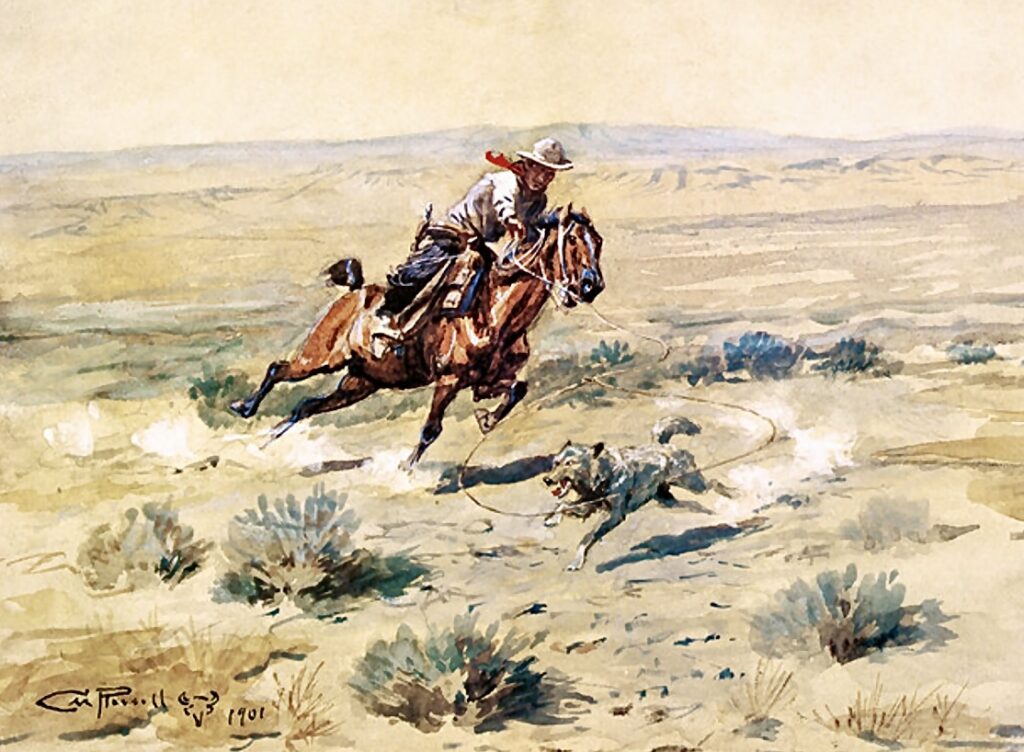
The North American Model of Wildlife Conservation is touted by hunters as a cornerstone of professional wildlife management in the US. The Association of Fish & Wildlife Agencies is recognized as an organization that promotes the highest standards of ethics guiding state wildlife management and the Wyoming Game and Fish Department is a proud member. At the association’s 100th anniversary celebration held at Big Sky, Montana in September 2002, its members formally endorsed the tenets of the North American Model of Wildlife Conservation, one of which is: “Wildlife may only be killed for a legitimate, non-frivolous purpose.”
Lisa Robertson, a longtime Jackson Hole conservationist, founded the non-profit organization Wyoming Untrapped that has vociferously called for trapping reform. She also brought the issue of snowmobilers running down wildlife to the Game and Fish Commission in 2019 shortly after I spoke with Nesvik. Appointees of earlier commissions, who often have been outfitters, guides, ranchers or big game hunters have consistently rebuffed calls for change. Wyoming Untrapped and a coalition of other wildlife conservation organizations have also been highly critical of Wyoming allowing controversial private wildlife killing contests on public and private land that award prizes to contestants who shoot the most wolves, coyotes and other species based on the disproved premise it results in better protection for livestock and game animals.
Not long after Gov. Gordon posted his comment on April 7, 2024 about the Roberts incident, Wyoming Game and Fish, which had come under criticism for its earlier portrayal of the wolf being “euthanized,” published this statement that quotes Nesvik, using it to justify why Roberts was only subjected to a $250 fine and blaming lax punishment on the absence of a law forbidding it.
Verbatim, the statement reads:
“The Wyoming Game and Fish Department has received a considerable amount of phone calls, emails and social media messages involving the possession of a live wolf in Sublette County. The department investigated this incident and cited one person.
‘The actions and behaviors of the individual involved in this case are not reflective of Wyoming’s values for wildlife,’ Game and Fish Director Brian Nesvik emphasized. ‘The actions that came to light in this case were disrespectful to wildlife. These actions were not in keeping with conservation principles or ethical behavior. This incident casts a shadow over our state’s proven track record in successfully and responsibly managing our gray wolf population.’
“The actions and behaviors of the individual involved in this case are not reflective of Wyoming’s values for wildlife. The actions that came to light in this case were disrespectful to wildlife. These actions were not in keeping with conservation principles or ethical behavior. This incident casts a shadow over our state’s proven track record in successfully and responsibly managing our gray wolf population.”
Brian Nesvik, director of the Wyoming Game and Fish Department
The individual was cited for a misdemeanor violation of Wyoming Game and Fish Commission regulations, Chapter 10, Importation and Possession of Live Warm-Blooded Wildlife. The department’s investigation indicated there were no other statutory or regulatory violations. The incident occurred in a part of the state where gray wolves are legally classified as predatory animals. Predatory animals are not managed by the department and animal cruelty laws, per Wyo. Stat. Ann. 6-3-1008 (a)(vii) do not apply to predatory animals. The department acknowledges the significant concern and dismay expressed by many people from around the state and nation.”
Again, as with Gov. Gordon, the same set of clarifying questions seem warranted, including this: If the head of Wyoming Game and Fish said the Roberts incident was not in keeping with conservation principles or ethical behavior and “the department acknowledges the significant concern and dismay expressed by many people from around the state and nation,” why didn’t it support putting tougher laws on the books? Why has it not challenged the “predator status” that not only declassifies wolves as wildlife over the state and specifically enables behaviors that violate ethics, fair chase and tenets of the North American Model of Wildlife Management?
While director Nesvik described Roberts’ actions as being “disrespectful to wildlife”—wolves are given full wildlife status in the northwest corner of the state, encompassing around fifteen percent of Wyoming. There they are classified as “trophy game animals” and aggressively hunted outside the national parks. Wolves are not classified as wildlife where the wolf in Sublette County was killed. Roberts was not charged with cruelty to animals because the way the laws read wolves are not entitled to being treated with humaneness.
By comparison, anti-cruelty provisions are extended to all big game species, plus livestock, horses, and household pets. In the case of deer, elk, moose, pronghorn, cows, sheep, and horses, it is also illegal for domestic dogs to harass those animals and pets can be killed if they’re caught in the act of harassing wildlife. (Mountain lions can be chased by aggressive dogs). In 85 percent of Wyoming, wolves are bestowed with no more protection than exotic rats.
Kristin Combs, executive director of Jackson Hole-based Wyoming Wildlife Advocates, claims the arguments flowing from Wyoming officials are part of an ongoing attempt to evade accountability. In recent days, Gov. Gordon has made efforts to create an informal review panel to assess possible lessons learned from the Roberts’ incident but he has not extended an invitation to citizens and conservationists who have criticized his handling of it.
“It took a long while for officials of state government to come out and condemn this and their silence was their complicity,” Combs said. “When there are things happening that are this egregious, it doesn’t matter what the animal is, at some point you’ve got to draw the line and not accept that this is how we do things in Wyoming. For too many years predators have been demoted into a subclass of wildlife. Yes, there are a lot of other states that still allow for predator control if needed, but still hold people accountable for acts of torture, torment and cruelty. As a 21st century society, we’ve said that’s just not okay.”
Combs says the incident has provided a jarring wake-up call for the rest of the country among people who were unaware of the flagrant hostility that’s being directed at wolves in Wyoming and the rest of the Northern Rockies.
Wyoming, “believing it was being clever,” deliberately created its own paradox of classification with wolves and now it’s ensnared in a problem of its own making, says Carter Niemeyer who spent decades on the front lines of predator control campaigns in the West. Niemeyer made his living working for both federal and state governments in trying to solve livestock-predator conflicts and he admits on many occasions predators were lethally removed but he also says claims of predator impacts on livestock and game animals have been grossly exaggerated, something often not explored by the media.
What Wyoming officials describe as “our state’s proven track record in successfully and responsibly managing our gray wolf population” is actually controverted by this reality: Never in the 51-year history of the federal Endangered Species Act has a species that’s been deemed biologically recovered been immediately, upon its delisting, subjected to an overt state-driven campaign to re-annihilate it and keep its numbers at the lowest levels it can but still prevent re-listing.
A similar stratagem exists in Idaho, though there, statewide, wolves are classified as game animals yet still are having their numbers knocked down by relentless hunting and trapping pressure plus aerial gunning and bounties. Montana has tried to follow suit but it’s been met by a pushback from citizens.
Niemeyer believes the Roberts incident could—and ought to—become a catalyst that not only brings national public attention to bear on the brazen anti-predator attitudes that exist in Wyoming, Montana and Idaho, but that it also bursts the mythology they are based on. “Wolves and coyotes are not an existential threat to ranchers, farmers and the ag industry. And they’re not a scourge on elk and deer populations,” Niemeyer says. He added that, except for the rarest of exceptions that include sick or food-conditioned wolves, they are not a danger to humans either.
Niemeyer knows. For three decades he investigated reports of livestock predation by wolves, coyotes, mountain lions, grizzly and black bears and even eagles. And many states still enlist him as a consultant in helping to non-lethally resolve conflicts.
Niemeyer questions Wyoming’s credibility with its assertions that it will be a responsible conservation steward of grizzly bears in the Greater Yellowstone region if, or when, they are removed from federal protection and their management handed over to the states. Just like its wolf management strategy that limits where wolves can wander, Wyoming has laid out a plan that would make grizzlies expendable, and subjected to higher hunting quotas if bears venture into areas that it arbitrarily deems “low human tolerance zones.” This includes vast sweeps of federal public lands where cattle and sheep graze.
Wyoming harbors a grudge it can’t get over, Niemeyer says, even though, ironically, the recovery of grizzlies and wolves has brought far more economic rewards than it has cost the state. He has the strong sense, he says, that some lawmakers in Wyoming, Montana and Idaho still resent the fact that grizzlies receiving federal protection in 1975 was done in protest from livestock groups, and that wolf reintroduction in Greater Yellowstone and Idaho happened in spite of opposition from the ranching industry and some hunting organizations.
Wyoming harbors a grudge it can’t get over, Carter Niemeyer says, even though, ironically, the recovery of grizzlies and wolves has brought far more economic rewards than it has cost the state. He has the strong sense, he says, that some lawmakers in Wyoming, Montana and Idaho still resent the fact that grizzlies receiving federal protection in 1975 was done in protest from livestock groups, and that wolf reintroduction in Greater Yellowstone and Idaho happened in spite of opposition from the ranching industry and some hunting organizations.
Wyoming is the same state where a hunter killed a wolf south of Jackson Hole, then strapped the bloody animal to the top of his SUV and drove it around the Town Square in downtown Jackson as a way to upset wolf advocates in that conservation-minded community. The same man later wrote to the local newspaper boasting that he allegedly had killed Grizzly 399 as she and her cubs were headed to the den. Fortunately not true, it was intended to taunt bear advocates. As a historic footnote, it wasn’t until 2021 that Wyoming officially put a law on the books, and was one of the last states in the nation to do it, outlawing bestiality after a man was caught allegedly engaging in sex with a horse.
Wyoming is also the state that has taken a variety of evasive strategies intended to delay closure of 22 elk feedgrounds, this despite knowing, based on overwhelming scientific evidence, that they are breeding grounds for the spread of Chronic Wasting Disease. CWD is an incurable, always fatal malady that attacks the brain and neurological function of deer family members (deer, elk and moose) and has grave implications for the survival of elk and deer herds over time. Epizoologists also warn there is the potential for it jumping the species barrier and afflicting people who consume contaminated game meat. Scientific studies suggest that having healthy populations wolves, bears, mountain lions and coyotes can help slow the spread of CWD because they prey on sick ungulates and cannot themselves catch the disease.
Niemeyer says Wyoming’s defiant frontier mentality has enabled it to ignore science, the concerns of tourists, and modern thinking that pertains to best practices with wildlife conservation, is coming back to bite the state.
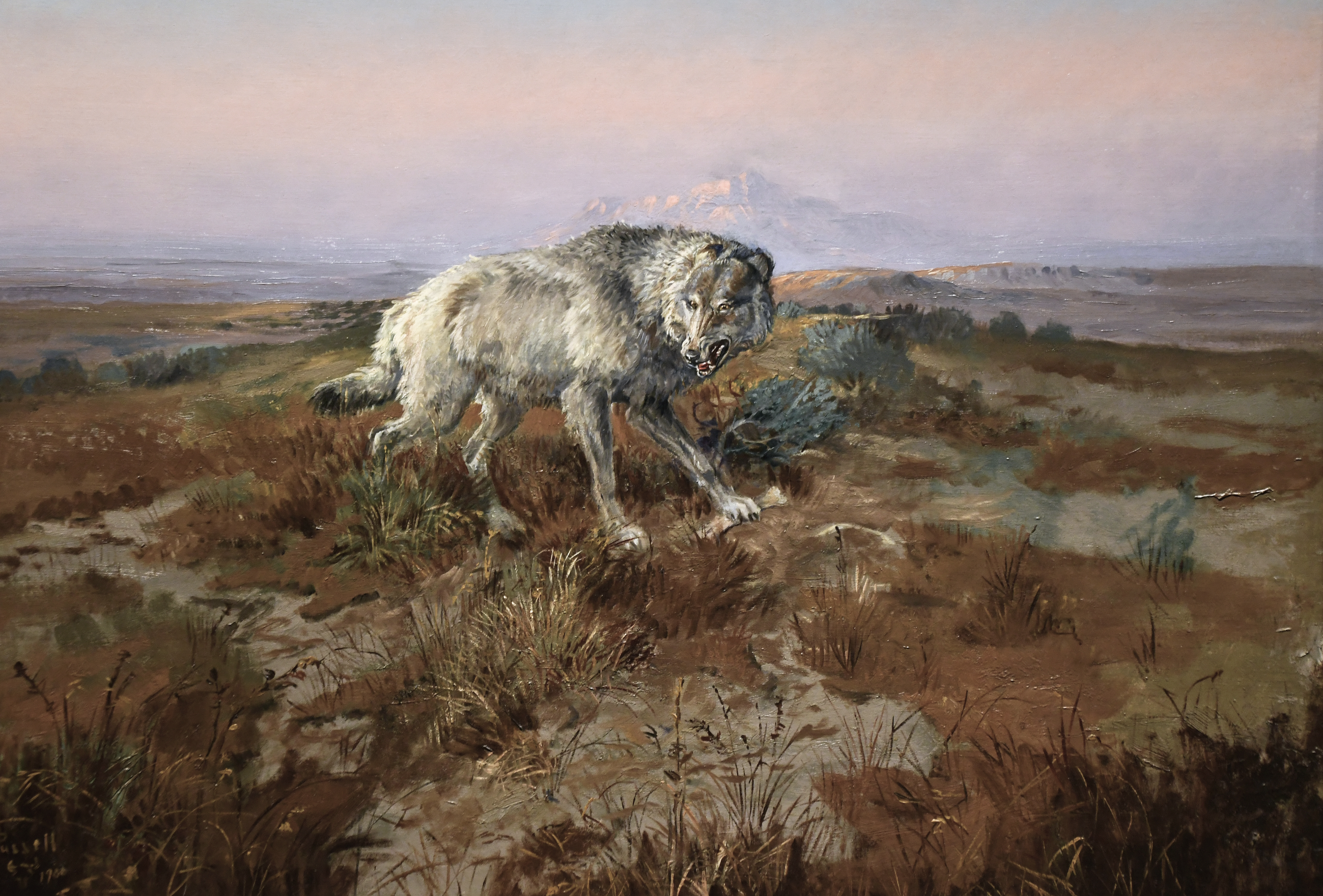
The Roberts case has touched people in the same way that the killing of Cecil the lion did, says Kim Bean, president of the wolf advocacy group, Wolves of the Rockies. Bean has fielded calls from people in Europe, the Middle East and Asia.
“Cody Roberts needs to be held accountable for what he’s done, but it’s the system, which enabled him, that killed this wolf,” Bean says. “He’s a product of a culture whose hostile attitudes toward certain public wildlife have both been inflamed and represented in the laws and regulations created by elected officials and condoned by those in charge of public wildlife. Of course when you have what you have in Wyoming and other states, it’s going to bring out the sadistic side of people who think they are being heroes.”
Bean called attention to “another whacky irony,” which is that Roberts was charged with possessing a live, a warm-blooded animal, meaning he might not have faced any penalty whatsoever had he killed the wolf by running over it with his snowmobile or until it was so fatigued it dropped dead. “The way animal cruelty is rationalized and in some ways condoned and protected is messed up,” she said. “The people who have orchestrated Wyoming’s lethal attitudes toward wolves are not very smart but they have been brilliant at trying to minimize accountability for bad behavior.”
Bean’s organization is offering a reward that has grown to more than $5,000 for anyone who provides compelling video footage related to Roberts’ actions. She promises that tipsters can remain anonymous.
° ° ° °
Culture in states where species are brought back matters and ultimately it will shape whether ongoing recovery will succeed, or not, as human pressures mount, says Dr. Christopher Servheen, a biologist who for 35 years oversaw national grizzly bear recovery in the Lower 48 for the US Fish and Wildlife Service. Now retired, Servheen is a trustee on the Montana Wildlife Federation board and he’s co-chair of the multi-nation International Union for Conservation of Nature’s North American Bear Experts Team. He and his IUCN colleagues around the world spend a lot of time pondering the variables that enable wildlife carnivores to survive and, as human populations grow, prospects for many species are dimming.
The public may not understand how extraordinary it is to recover species or re-wild places. Northern Rockies states, Servheen says, can be lauded as beacons in embracing conservation of wolves, grizzlies and potentially wolverines and Canada lynx, not as something imposed upon them but as an opportunity most don’t have to proudly differentiate themselves.
Wolf and grizzly recovery have been called two of the greatest achievements in the modern history of wildlife conservation worldwide yet many elected officials, he says, seem to believe they are living at the end of the 19th century when backward thinking prevailed, nearly wiping out a lot of species.
In recent years, Servheen has reversed his longstanding support for removing grizzlies from federal protection based on actions taken by states in the Northern Rockies that weaken bear protection and, he believes, will give states an impetus to kill more bears. After Servheen read the statements issued by Gov. Gordon and Wyoming Game and Fish relating to the Roberts wolf incident, Servheen sent this note to his colleagues on the Montana Wildlife Federation board and its staff.
“As a hunter,” he wrote, “I am disappointed Wyoming Game and Fish could not bring itself to more strongly criticize the depraved behavior of a person calling himself a hunter who tortured and publicly displayed a live wolf in a bar for his pleasure and to show what kind of person he is to his ‘friends.’ Such behavior brings shame on all of us in the hunter community and is in no way representative of how ethical hunters behave. Wyoming Game and Fish had a chance to speak out against such unsportsmanlike behavior and they did as little as possible. They failed.”
Servheen added, “Only a small minority of the public hunts and to have this type of crass, depraved behavior from a so-called hunter darkens the image of hunting in the eyes of the non-hunting public. Such depraved and cruel behavior is not representative of hunters in any way and Montana Wildlife Federation strongly condemns this behavior.”
I asked Servheen about what implications, if any, the public can derive from Wyoming’s attitude toward wolves that might be applied to citizens concerned about it managing grizzlies. “Ethical treatment of wildlife, particularly carnivores, requires that these animals be respected as native species and not demonized to somehow justify unscrupulous behavior. One can only hope that attitudes toward grizzly bears do not descend to the unjustified hatred that certain people have for wolves. This will depend on state policies toward grizzly bears and how the states respond to the unethical killing of grizzly bears and wolves,” he said. “The states should set an example and be leaders in forcefully responding to this unethical behavior with a strong legal response and with public statements deploring the completely unethical and depraved behavior of this individual and how he treated this wolf.”
° ° ° °
Lest anyone think it is an outlier, Wyoming doesn’t stand alone. In Montana, its governor Greg Gianforte has drawn national criticism for some of his anti-wolf and anti-grizzly rhetoric that, at best, could be termed exaggerations.
A few winters ago, Gov. Gianforte shot and killed a wolf, that was part of ongoing Yellowstone research, after it wandered outside the park and was caught in a leghold trap. The animal was kept in the trap until Gianforte could shoot it. A year later, Gianforte shot a mountain lion, also part of a transboundary Yellowstone research project that had moved north out the park and then was treed by a houndsman with dogs. Gianforte reportedly shot the wild cat, unable to flee, out of the tree. In both instances, he was roundly criticized for engaging in hunting practices that critics said violated fair chase ethics and that he, as head of state, ought to set a better example. Back in 2017, when Gianforte was running for Congress, he body slammed a reporter for The Guardian newspaper at a political event in Bozeman and his spokesperson denied the incident happened until audio evidence was produced.
Pleading guilty to a misdemeanor assault charge, he was sentenced to 40 hours of community service and 20 hours of anger management classes. Despite this, voters elected him to public office.
Notably, regarding wolves, Gianforte and members of the Montana Fish and Wildlife Commission, which he appointed, established a controversial hunting quota that resulted in nearly a quarter of Yellowstone’s wolf population being killed by trappers and hunters when pack members moved north out of the park during the winter of 2021-2022.
Doug Smith, who was chief Yellowstone wolf biologist during that winter, had spoken out about the trauma befalling wolf social structure in the park that resulted from those killings. It included annihilation of an entire pack that had been popular among Yellowstone wolf watchers. I asked Smith, who retired from his post after being a government biologist for three and a half decades, to share his perspective on the Roberts’ incident.
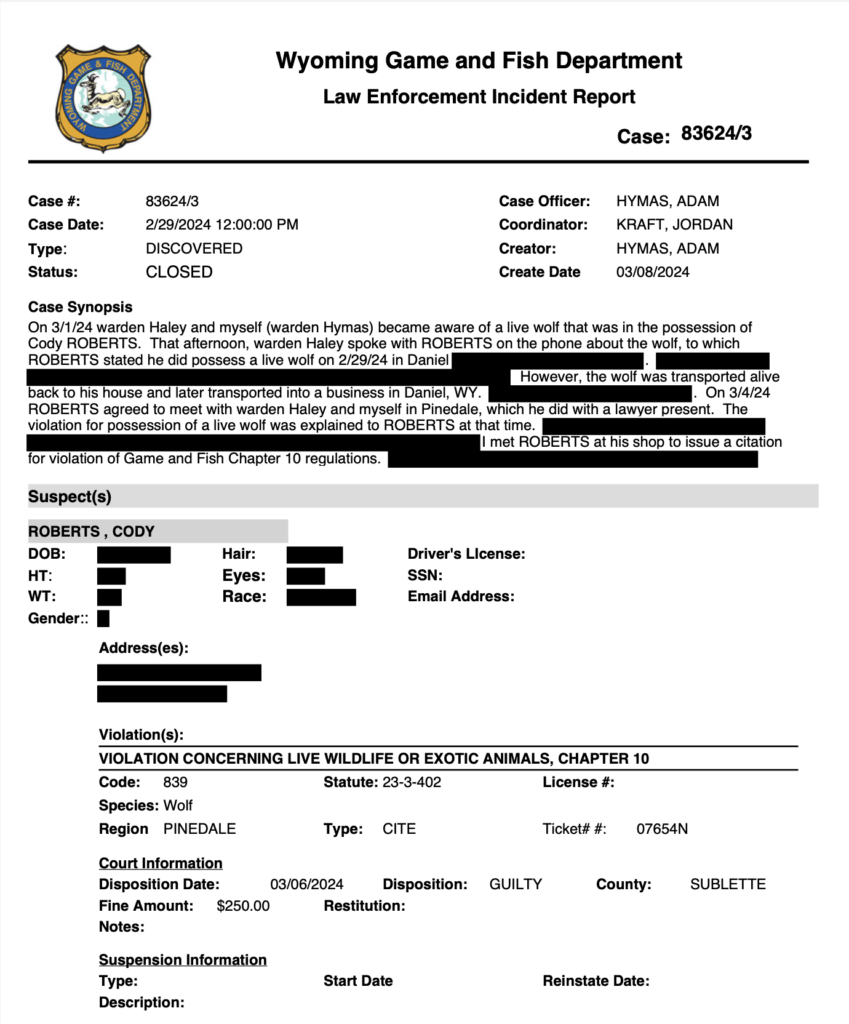
“Sometimes the best way to affect change is in the middle—the moderate approach. Wolves sorely need this kind of thinking. Unfortunately with acts as reprehensible as this we’ll never get there. I try very hard to understand why running down an animal with a snow machine is legal. I do this because many rural people hate urban intrusions to their way of life. But that is exactly why so many cry out, any time chasing an animal down, then running it over multiple times with a snow machine is legal – is why locals won’t be left alone. And all that happened before the animal’s mouth was taped shut and hauled around to a bar and laughed at and the penalty is 250 bucks. I understand now why so many believe wolf management cannot be left to the locals,” he said.
An elk hunter himself, Smith added, “This is not hunting, this is not fair chase, this is nothing but animal cruelty and torture and should not be tolerated or allowed. It’s embarrassing to hunters that this person is a hunter. Sadly this is the entire history of wolves and humans and we can’t ever seem to move on. Human progress is slow, very slow and a non-human life will continue to pay and suffer for that. What a sad day for hunting and the ethical treatment of wildlife.”
While Gov. Gordon and Wyoming’s state wildlife director Brian Nesvik tried to explain away the lack of harsher legal consequences for Roberts, basically saying the laws as they exist wouldn’t allow them to do more, critics say Wyoming had every opportunity to revise the laws in recent years but deliberately didn’t.
° ° ° °
In the aftermath of my story in 2018, two Greater Yellowstone-based legislators sought to enact laws to prohibit the pastime known as “coyote whacking” by running animals down with snowmobiles.
State Rep. Mike Yin, a Democrat from Jackson Hole, Wyoming and a counterpart in Montana, State Sen. Mike Phillips, a Democrat from Bozeman, Montana, each drafted bills they planned to introduce to their respective state legislatures that would outlaw the controversial practices. Both had been appalled by videos they saw, actually produced by Wyoming snowmobilers documenting themselves running over and crushing coyotes in the snow. The videos appeared with my story before they were removed from youtube for being deemed too graphic and offensive.
In Montana, coyotes hold “varmint” status and can be killed by anyone, without a license, any time of year. Since terminology matters, it’s helpful to again invoke a dictionary definition. The Oxford English Language Dictionary refers to varmint as “a troublesome wild animal” or “a troublesome and mischievous person, especially a child.”
Chasing down coyotes with snowmobiles is also tolerated in Montana and Idaho. In the Treasure State, wolves are classified as a “game animal” and the activity is prohibited. The bills drafted by Yin and Phillips not only failed to get public airing but also votes before their legislative bodies. Republicans did not want to have the merit of the legislation debated publicly.
Yin’s bill, which faced stiff resistance from livestock and big game hunting interests, would have made it a crime of “animal aggravated cruelty” for anyone who “uses a snowmobile to willfully or wantonly cause the death, injury or undue suffering of an animal, including a predatory animal.” Read this report from the Jackson Hole News & Guide headlined “Bill to Ban Coyote Whacking is Run Down” about what happened in Wyoming.
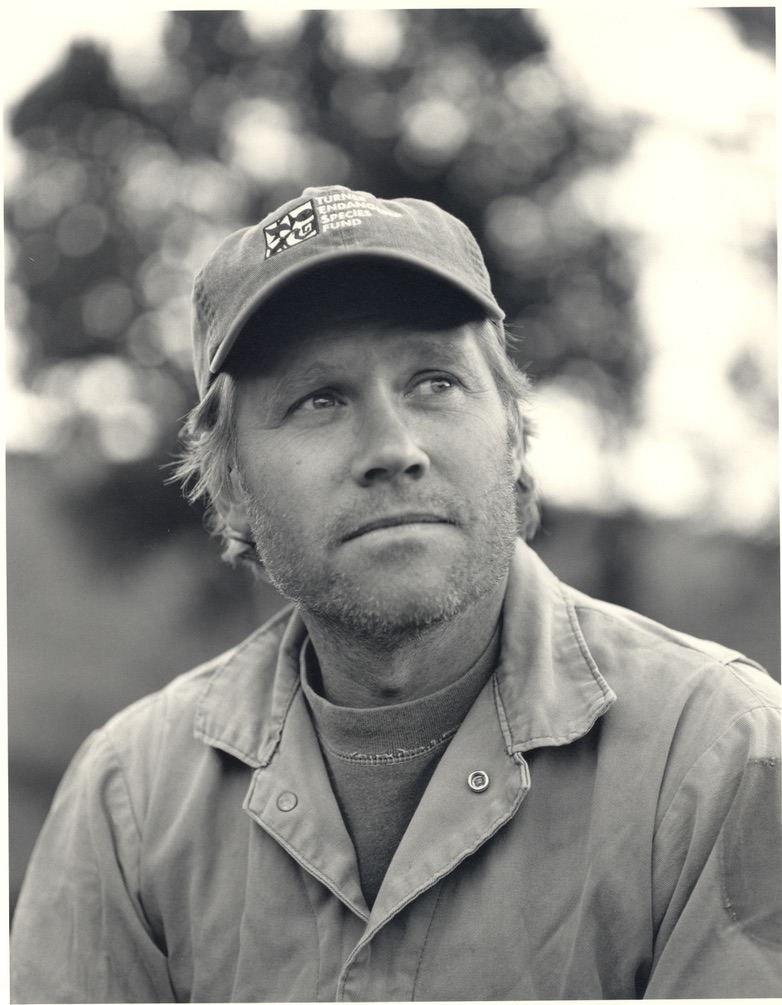
Note: Wyoming has a law on the books that protects “trophy or big game animals from wanton, ruthless or needless destruction” and offers monetary rewards to those who provide anonymous tips resulting in the arrest and conviction of individuals found guilty of committing that offense. Repeat offenders can be charged with a felony punishable by a fine of up to $10,000 and imprisonment for up to two years. It’s a category of ill-repute on a par with poaching.
In Montana, Phillips, a lifelong hunter, renowned wildlife biologist and conservationist, made several attempts to get a couple of bills passed but he, too, “ran into a brick wall of opposition” from his Republican colleagues. One Senate committee chairman told him that allowing the bill to be openly debated and then put to a vote in the full Senate would cost the Republican his standing with his GOP peers. Many of them, he said, claim that the only good coyotes are dead coyotes—the implication being that people who make sport out of running coyotes down with snowmobiles are giving the animals the treatment they deserve.
Phillips isn’t a casual observer when it comes to wolves. He studied under the eminent wolf biologist L. David Mech and was intimately involved with the US Fish and Wildlife in trying to restore red wolves to the Southeastern US. After that he was tapped to oversee wolf reintroduction to Yellowstone, and, as a co-founder of the Turner Endangered Species Fund, he and his colleague Val Asher have been studying a wild wolf pack on Ted Turner’s Flying D Ranch outside Bozeman for two decades. Few Montanans and other citizens in the Northern Rockies may be aware of Phillips being stonewalled in the legislature because little coverage of his efforts was reported in the media.
Servheen’s former boss, Dan Ashe, who oversaw the US Fish and Wildlife Service when wolf management was turned over to Wyoming, told me he endorsed wolf delisting and he signed off on the state’s plan because he had faith the animals would be treated ethically and humanely. Recently, Ashe expressed remorse because the laws in place are not achieving those results and may be undermining the spirit and long-term objective of biological recovery.
The Endangered Species Act is viewed as the most foresighted wildlife protection law in the world because it not only prevents species from going extinct or being extirpated, but it also communicates a message that species have a priceless intrinsic worth that ought to be protected, Ashe told me during one of our many chats over the years.
If one talks with biologists and reads the voluminous body of research into canid behavior, wolves and coyotes are highly social animals that normally live and hunt in packs; they’re also intelligent, family-oriented and have an emotional range, with an acute sense of being that surpasses that of their domesticated descendants, i.e. all of today’s beloved dog breeds.
“This is the worst thing I have ever seen as a wildlife advocate in my life and I have been doing this for 30 years,” says Wendy Keefover, senior strategist for carnivore protection with the Humane Society of the United States of the Roberts incident. “I would say my current response to what he allegedly did is one of shock. We’ve known people were running coyotes over with snowmobiles, but the chain of events and the duration of the cruelty he inflicted on the wolf has shaken me to my core. It’s so atrocious and hard to fathom that somebody would do this, and then be able to get away with it because leaders in the state make it allowable.” Also, read the essay Keefover wrote for Writers on the Range.
This is the worst thing I have ever seen as a wildlife advocate in my life and I have been doing this for 30 years. I would say my current response to what he allegedly did is one of shock. We’ve known people were running coyotes over with snowmobiles, but the chain of events and the duration of the cruelty he inflicted on the wolf has shaken me to my core. It’s so atrocious and hard to fathom that somebody would do this, and then be able to get away with it because leaders in the state make it allowable.
Wendy Keefover, senior strategist for carnivore protection with the Humane Society of the United States
The Humane Society and a dozen other organizations recently filed suit against the US Fish and Wildlife Service and its parent agency, the US Interior Department, to have federal protections for wolves restored based on aggressive lethal control being exercised by Wyoming, Montana and Idaho. They say those states are egregiously obliterating the intent of the Endangered Species Act and its objective of achieving biological recovery.
Keefover said it’s perverse that wolf persistence depends upon the animals surviving in spite of state policies. Instead, recovery ought to be a reflection of states nobly enacting codes that honor wildlife conservation and demonstrate leadership in human-wildlife co-existence. Making wolves and coyotes symbolic scapegoats and treating them lethally as enemies of the state is a dark reflection, she says, on human character.
Phillips told me in 2019 that with his bills, he was not protesting the hunting of coyotes and other predators if done according to ethical standards. But he believes chasing down coyotes with snowmobiles and portraying it “as a kind of fun sport in Montana is barbaric and a form of torture that has no place in the modern world.”
What few in Greater Yellowstone know is that Phillips helped co-write the language which went into a historic ballot measure in Colorado, narrowly approved by voters, that resulted in wolves being reintroduced there late in 2023.
“I understand that some people just can’t get over their hatred of coyotes [and wolves], but all wildlife species should enjoy the benefit of professional wildlife management, which has legal and ethical rules for engagement,” he said at the time he drafted his legislation in Montana. “Running down coyotes or any other animal, for that matter, with snowmobiles, isn’t ethical hunting nor is it responsible wildlife management. That kind of activity should be illegal and if it’s not called out as reprehensible and made illegal, then the message is ‘it’s condoned.’”
Humane treatment of animals is not, and ought not be, a partisan issue, Phillips says, noting that many of his self-identifying Republican friends love all animals. Unfortunately, he noted, legislatures in Montana, Wyoming and Idaho have made a basic issue of decency political.
At a public event called “Night of the Wolves” in Bozeman in 2022, Phillips was asked about the resistance he encountered from legislators. What he said, describing “their callousness,” drew gasps from the large audience. Every day when legislators meet in session at the state capitol in Helena, two daily rituals are practiced, he said. The first is a group prayer and the second is standing together and partaking in the Pledge of Allegiance.
Phillips to this day is incredulous that legislators who pray to God, utter the Pledge of Allegiance and claim to abide by hunting ethics would not condemn and outlaw that form of persecution against coyotes. Phillips drafted a series of bills. After they failed to even be put it to a vote, he told me the following in 2022 after reminding me that Gov. Gianforte proudly identifies as a Born-Again Christian who touts the teachings of Jesus. Phillips said that had Jesus been called to testify on whether his bills had merit or not, he has no doubt Christ would have spoken in favor of it and against policies that abide the torturing of animals.
“I was disgusted as people—my fellow elected officials—who claim to worship the Creator would have such vile disregard for the products of Creation.” Phillips said the failure to outlaw coyote killing with snowmobiles and using them as a lethal weapon should “be an embarrassment to the people of Montana.”
Here’s what Phillips told the crowd in Bozeman a year later about his experience as a legislator in Helena. He originally ran as a candidate, in part, he said so that he would apply his deep professional expertise as a biologist. Montana has long portrayed itself as being a national leader in wildlife management. In 2021, Phillips became the first elected official to be awarded the prestigious Aldo Leopold Award, the highest honor bestowed by The Wildlife Society, recognizing lifetime contributions to US wildlife conservation. Recipients include many of the giants in modern ecology.
Founded in 1937, the society is an international network of over 11,000 leaders in professional wildlife science, management and conservation. It publishes the Journal of Wildlife Management that is one of the premiere journals for wildlife research in the world.
“In the [legislative] session, I brought a bill that said you can’t torture coyotes to death in the state of Montana. Montanans are better than that. My bill said nothing about how many coyotes [a person could kill]. It didn’t prohibit hunting coyotes off a snowmobile. It simply said at the time, the coyote is exhausted. She’s laying there looking at you in the snowbank. She can’t move any further. At that point, you have to kill that animal humanely. You can’t run it over repeatedly with a snowmobile. That’s all the bill said. The bill died in committee,” Phillips explained, and added:
“I said to the Republican Majority Leader Fred Thomas [of Stevensville], ‘Fred, what kind of people do you represent that would want to make it lawful to run coyotes over with a snowmobile?’
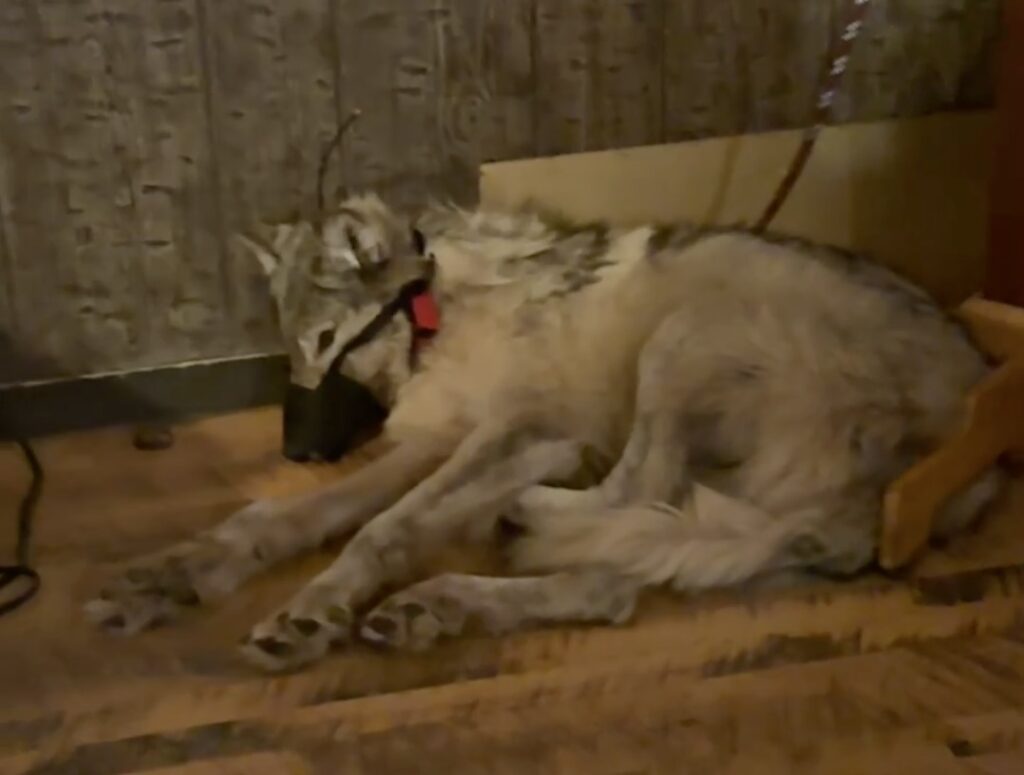
Thinking to himself that this lack of common sense is what’s precisely wrong with the current state of American politics, he went on, “I’d served for 14 years [in the Montana House and Senate] at that point in time [and] I could no longer pray with my Senate colleagues. That was a big deal for me. I’m not especially partisan. They were friends of mine for 14 years. I would stand with them every day and we would begin a session with a prayer and I would stand politely and share the prayer.
[But] from that point forward, I could only stand in the anteroom and mind my own business until the prayer was over. Then I stepped back into the chamber and pledged allegiance to the flag. I was sorely disappointed and sad that we couldn’t get the [Montana] Legislature to rise above the notion of torturing coyotes. So sad that I could not cotton to their hypocrisy any longer. I certainly wasn’t about to pray with them. There is no God that I would worship that would celebrate torturing coyotes.”
What just happened in Wyoming with wolves, he says, debases the state’s reputation. In the North American Model of Wildlife Conservation that Wyoming claims to hold up as a virtue, it reads: “Wildlife may only be killed for a legitimate, non-frivolous purpose.”
Longtime veterans of state wildlife departments in Wyoming, Montana and Idaho have told me good people are leaving the agencies because they are tired of doing things they don’t agree with, and they’re frustrated with political agendas trumping science. Perhaps the real question for Wyoming is a simple one: what have elected officials made it so hard to recognize wolves as wildlife and treat them with dignity? It isn’t like trying to resolve a wicked problem like achieving peace between the Israelis and Palestinians, Phillips said. “Wolves actually aren’t hard to live with,” he noted. “It’s people who make it hard.”
Phillips said the Roberts incident ought to bring shame upon those “who don’t have the courage to follow up their condemnation with actions to show young people it doesn’t reflect values of the state. Laws on the books reflect values and they shape culture.”
If people want an example of moral and ethical confusion in America, he says, its right there, present in Wyoming’s attitude toward wolves, for all to see.
Subscribe
Never miss a story, subscribe to our newsletter!

